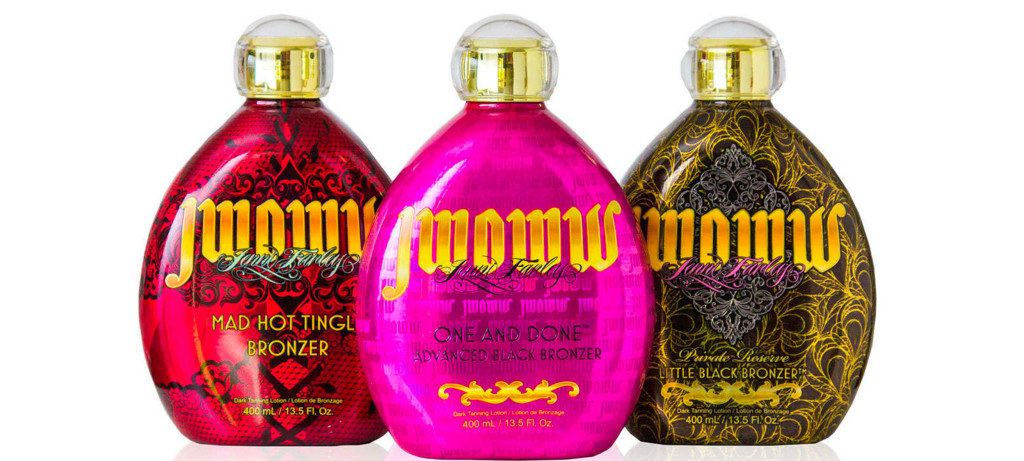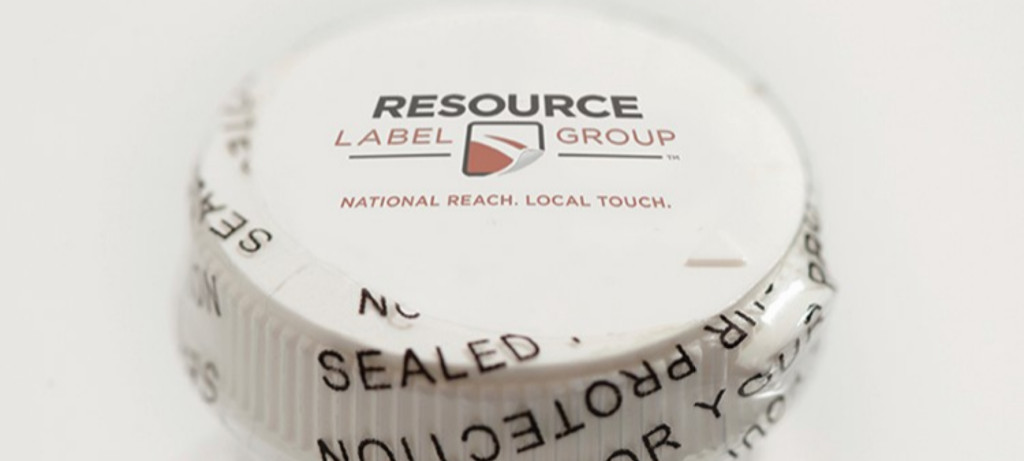The biggest problems extended content labels (ECLs) solve by market
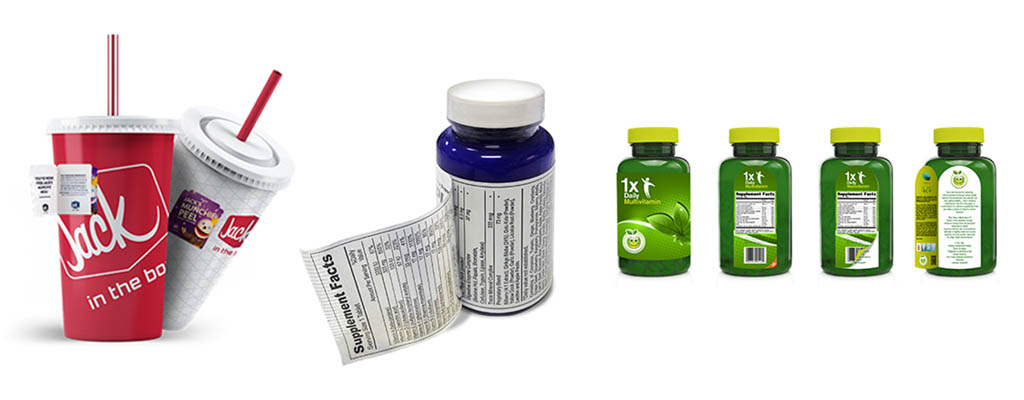
Brands don’t incorporate extended content labels (ECLs) into their packaging on a whim. They employ ECLs to solve regulatory, branding or space-related issues:
- Too much regulatory information to include on your standard label
- Cross-promoting products in your portfolio with on-package information and coupons
- Driving sales by delivering coupons to consumers at point-of-purchase
- Not enough label real estate to tell your full brand story
But the specific reasons ECLs are employed vary brand by brand, and market by market. Here, we’ll give you a tactical look at why competing brands in your market are employing ECLs. And, to take it a step further, we’ll examine what specific ECL products they’re using.
You can use the links below to quickly find the information you need:
- A quick primer on ECL product types
- ECLs for health & beauty brands
- ECLs for food brands
- ECLs for OTC pharma and nutraceutical brands
- ECLs for chemical brands
First, let’s make sure we’re using the same ECL vocabulary
The term “extended content labels” describes a very broad range of labeling products that provide the same general function: Increasing the amount of usable space on your label.
Due to the sheer volume of label products that fall into this category, it seems like every label converter has its own unique way of describing their ECL product offerings.
Here are just a few of the more popular terms: 2-ply labels, tear-off leaflets, fold-out labels, peel-and-reveal labels, dry-release labels, piggyback labels, multi-wrap labels, plow fold booklets and the list goes on.
And, to be fair, there are hundreds of variations on ECL products. But let’s keep it simple to make sure we’re all using the same vocabulary.
All ECL products — no matter how custom — fall into three categories:
- Smooth-peel labels
- Booklet labels
- Peel-free labels
Below, we’ll define these categories and show you several visual examples to give you a sense of the variability within each.
If you’d like a more comprehensive look at the many types of ECL products, and their corresponding names, you can give our guide a skim.
Smooth-peel labels
As the name implies, smooth-peel labels are designed to allow consumers to peel back your label to reveal additional content and, when they’re done, close the flap. These labels are either designed with a hinge (as with the “1x” and Jack in the Box labels) or wrap around the container one or more times (as with the wraparound supplement label). You also have the option of incorporating multiple pages into your smooth-peel label.
Booklet labels
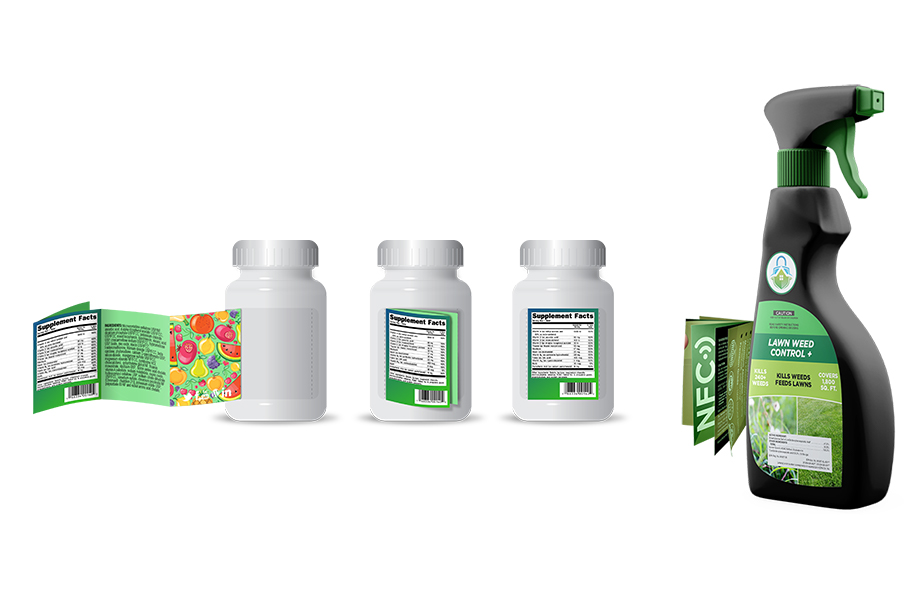
Booklet labels are constructed either to open like a book or unfold like a map, revealing pages of additional information with a relatively small on-package footprint. Look at this diagram to see all the folding options.
Peel-free labels
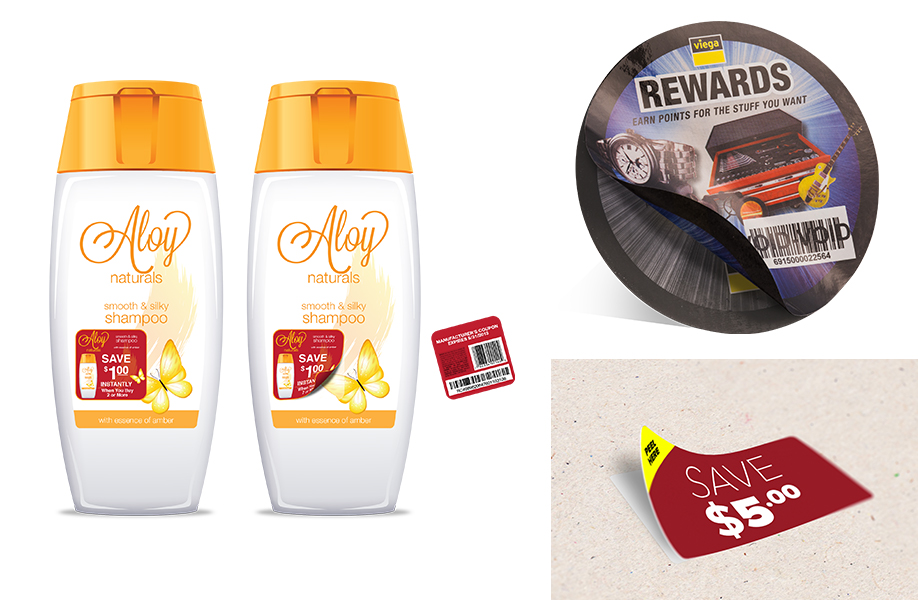
Peel-free labels look similar to smooth-peel labels but have one key difference: The top label comes off of the package completely. As seen above, these are often used for items that the consumer can remove and use instantly, such as instant-redeemable coupons (IRC) or game pieces.
Function first, form second
The products listed above describe how the label is constructed, not the end use. Each ECL type can serve any number of end-use functions. Any of the above products, for example, can be used as an IRC, to communicate key regulatory information or strengthen the story you’re telling on your package.
Because of this, form will follow function when selecting the right ECL product to achieve your brand’s goals.
We’ll first seek to understand what, exactly, your brand needs to accomplish with the added space provided by an ECL. Then we’ll use factors including budget and container size to guide you toward the best product for your brand.
For a closer look at what you should expect during an ECL product consultation, you can glance through this article.
Why health & beauty brands turn to ECLs
Best-fit products: Smooth-peel labels, booklet labels
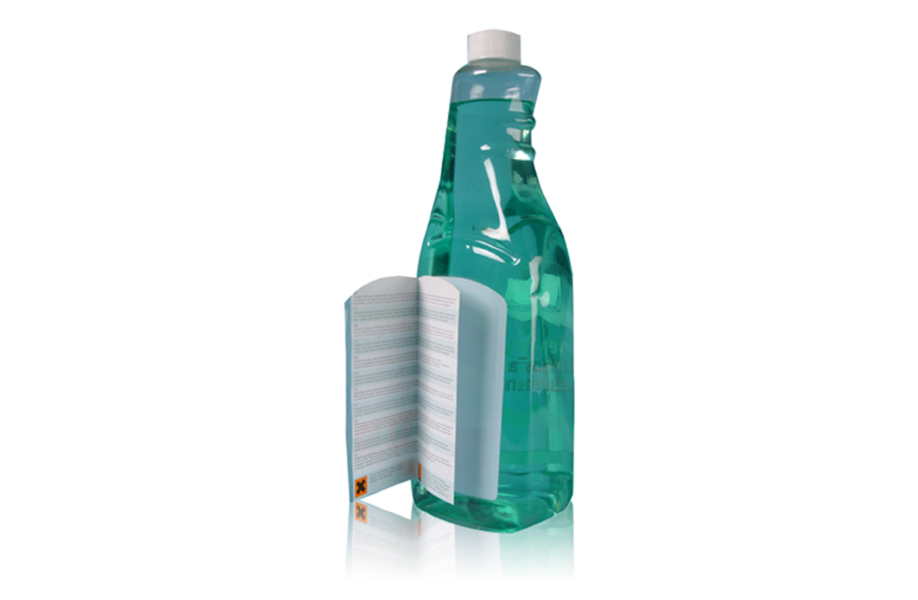
Market-specific challenges & opportunities
- Small packaging — Think of compacts, lip balms, nail polish. Packaging for health & beauty products can be tiny, and smooth-peel labels allow you to easily double the amount of label real estate.
- Multiple languages — Listing all product information in multiple languages (Spanish, French, English) takes up space. Smooth-peel and booklet labels are perfect solutions, allowing you to give consumers the information they need about your product without having a text-heavy front or back label.
- Fostering customer loyalty — Using the extra space on smooth-peel or booklet labels, you can create experiences that ensure consumers reach for your product again and again. You could, for example, add a QR code to a booklet label. When a consumer scans it, the QR code sends them to video tutorials of how to use the product in conjunction with other products in your portfolio.
Why food brands turn to ECLs
Best-fit products: Smooth-peel labels, booklet labels, peel-free labels
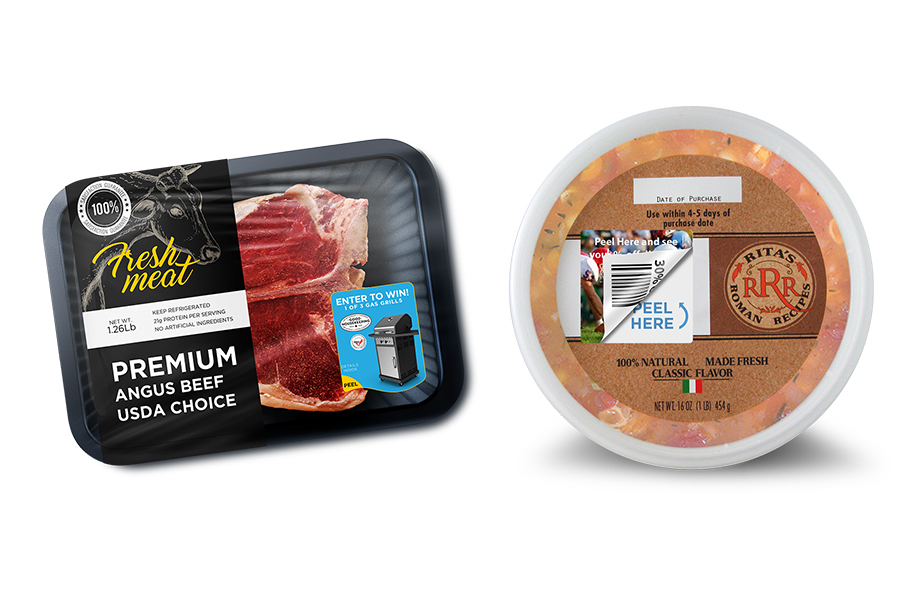
Market-specific challenges & opportunities
- Increasing label application throughput by combining your front and back label — Food brands with smaller packages, or those that only have one applicator, can use ECLs to combine the front and back label. For one cheese brand, switching to an ECL increased their label application throughput by 200% — see how.
- Driving point-of-purchase sales with instant-redeemable coupons — There’s a reason IRCs are a tried-and-true promotional tactic in the food industry. Messages like “SAVE 10% NOW!” give consumers the nudge they need to pick up your product and put it in their cart. Peel-free labels are a favorite for IRCs, although IRCs can be incorporated into smooth-peel or booklet labels as well.
- Cross-promote your other products with tasty recipes — Fill a booklet label with recipes that use all the products in your brand’s portfolio. And, if you’d like, you could incorporate a QR code leading to video instructions for each recipe. If you’re considering running an on-package promotion, this guide will help you understand how to get from concept to market.
- Achieve FDA compliance in style — The updated nutrition facts panel leaves little room on your back label for branding. You could increase your branding real estate by making your back label to a smooth-peel label, with the extra pages dedicated to brand storytelling, a key labeling trend.
Why OTC pharma and nutraceutical brands turn to ECLs
Best-fit products: Smooth-peel labels, booklet labels, peel-free labels
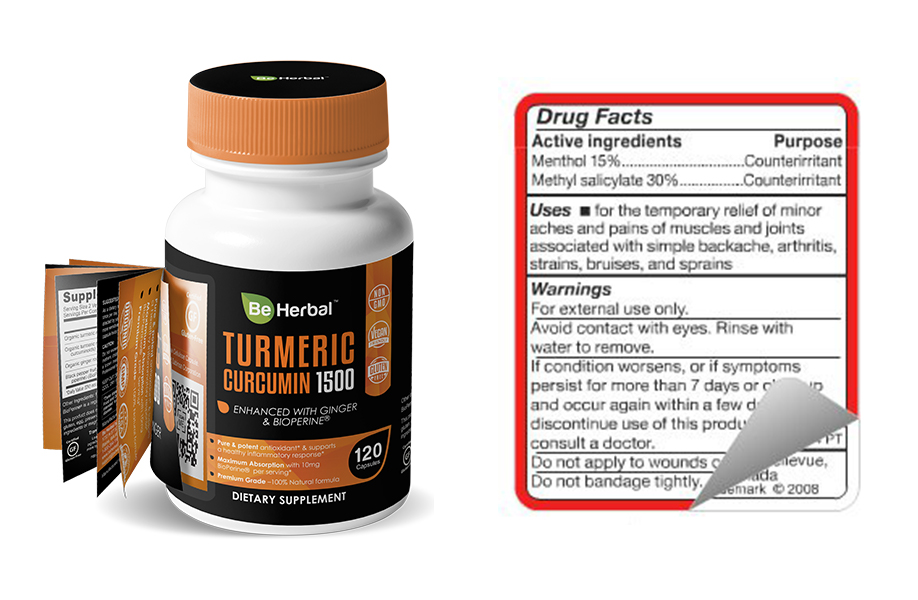
Market-specific challenges & opportunities
- Never sacrificing branding real estate in favor of communicating product use and safety information — Booklet labels are popular for OTC pharma and nutraceutical brands because of the ocean of information they have to communicate on the bottle. As pictured above, you can use the pages of your booklet to do a myriad of things: Display the supplement facts, tell your brand story and incorporate a QR code where consumers can interact with your brand. And you can do it without worrying about space.
- Tell the right story on your label — Consumers, especially those of supplements and nutraceuticals, are highly conscious of what they’re putting in their bodies. They actively seek out brands they feel they can trust. A smooth-peel label gives you double the space — or more — to communicate with consumers, telling a compelling story. To learn more about trends in the nutraceutical market, read through this guide.
- Ethical pharma protocols — In an effort to be transparent, many pharma manufacturers elect to communicate more information than is required. ECLs give them the space to add all the information they think patients need to know.
Why chemical brands turn to ECLs
Best-fit products: Smooth-peel labels, booklet labels
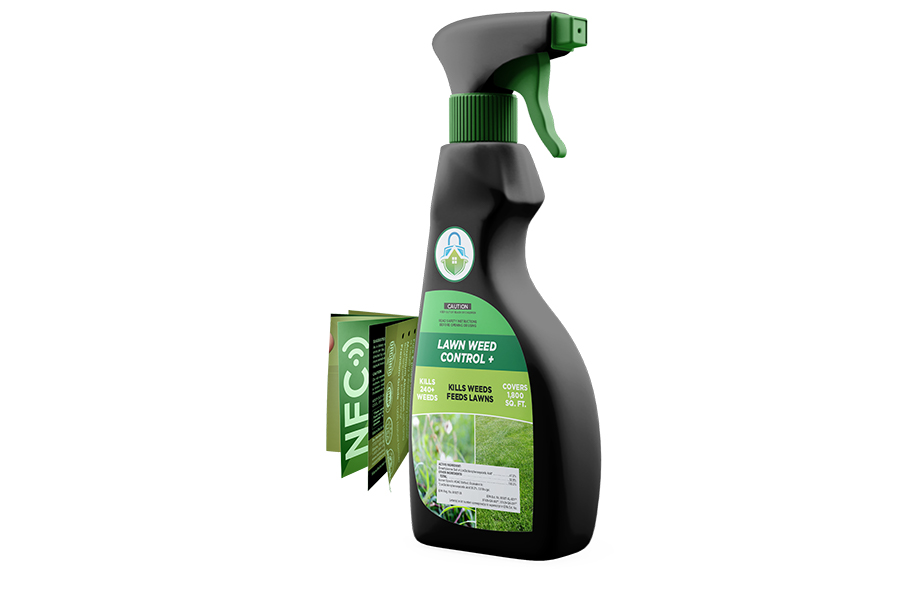
Market-specific challenges & opportunities
- Achieving compliance — Chemical product labels have to include a wealth of information — product identifiers, precautionary statements, pictograms and more. Because booklet labels can potentially have dozens of pages, you can include all required information with ease.
- Addressing the need for multiple sets of instructions — As multi-purpose household chemicals rise in popularity, smooth-peel and booklet labels offer a simple way to include multiple direction panels on your product container.
- Durability for industrial conditions — ECLs give industrial chemical manufacturers the confidence that end users will be able to access key safety, regulatory and use information, even in the harshest environments (UV exposure, moisture, chemical contact).
What could your brand accomplish with more label real estate?
ECLs allow you to go from worrying about space, to worrying about sending the right message on your packaging.
Tell us the unique packaging challenges you’re experiencing, and we’ll have a one-on-one discussion about whether an ECL could help and, if so, which type of ECL is best-suited to meet your needs. Reach out to our team today.
Find the best solution that makes the most sense for your brand.
Tags:

